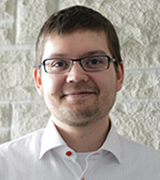Andrew Pruszynski

Scientist
Why I Became a Scientist
I was always interested in how things worked. Sometimes that meant building things, but usually it meant breaking them. So, naturally, I decided to complete an undergraduate degree in electrical engineering. This choice had the extra benefit of annoying my father who was a proud chemist. Toward the end of my degree, I became interested in designing and building robots and other biomedical devices. In particular, I worked on a robotic device for the rehabilitation of gait in stroke patients with the idea of providing rapid intervention following trauma. I learned a lot from this experience. Mostly that we can build great robots, but that we don't really understand how to use them to recover function because we lack even a basic understanding of the neural mechanisms that underlie healthy movement. This simple revelation forced my hand at becoming a scientist, which I did via a PhD in Neuroscience.
Research Summary
Motor behavior and sensory perception appear effortless but actually reflect a myriad of complex interactions between the mechanical properties of the body and a highly distributed neural circuit. The goal of my research is to explain how the nervous system handles and exploits these interactions when moving and manipulating objects. Addressing this issue under naturalistic conditions is essential to our basic understanding of sensorimotor function and may lead to better treatment following trauma and disease which often disrupt these interactions.
Research Questions
Do reflexes account for limb mechanics during naturalistic object manipulation?
My doctoral research established that fast feedback responses (i.e. reflexes) of the upper-limb exhibit a degree of sophistication typically reserved for voluntary movement and suggested that these common capabilities reflect a common neural substrate. I plan to extend the previous experimental approach, which was constrained to arm movements in the horizontal plane, to a more naturalistic object transport and manipulation task where a broader array of sophistication can be assessed. Establishing the extent of functional and neural overlap is critical to furthering theories of motor control which posit that voluntary movement is generated by actively manipulating sensory feedback.
How does the nervous system compensate for motor noise and internal perturbations?
My research to date has focused on how the nervous system responds to mechanical perturbations applied by an object or device that is external to the body. More ubiquitous and certainly less studied are those perturbations created by our own nervous system because of the physiological noise associated with generating motor commands and transforming them into movement. Although it is recognized that the nervous system compensates for such internal perturbations and that not doing so is a feature of many diseases including tremor, little is known about how the nervous system accounts for this fundamental property of the peripheral apparatus.
How does the nervous system account for the mechanics of the limb it controls?
Do first-order neurons in the skin extract high-level features of contacted objects?
How does the nervous system account for motor noise?
Education
- B.ASc (Hon), Electrical Engineering, Simon Fraser University (2004)
- Ph.D, Neuroscience, Queen's University (2011)
Training
- Umea University, Sweden (2011-2014)
- Long-Term Fellowship, Human Frontier Science Program
- Postdoctoral Fellowship, Canadian Institutes for Health Research
Awards
- Governor General's Academic Gold Medal, Queen's University
- Outstanding Achievement Award, Centre for Neuroscience Studies, Queen's University
Publications
Contact Info
Robarts Research Institute
Western University
Email: andrew.pruszynski@uwo.ca








